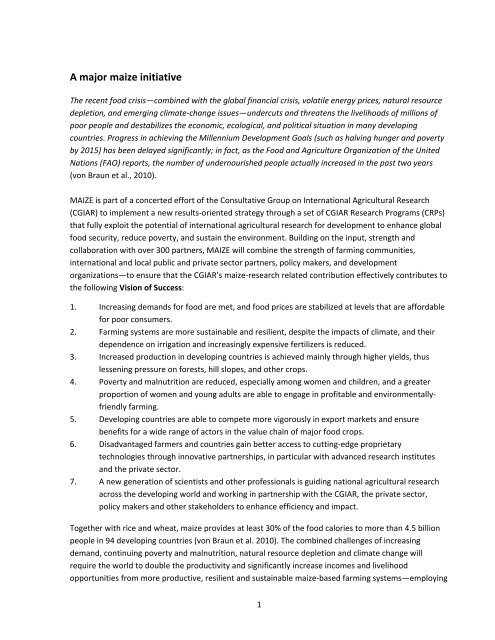Download - Maize
Download - Maize
Download - Maize
Create successful ePaper yourself
Turn your PDF publications into a flip-book with our unique Google optimized e-Paper software.
A major maize initiative<br />
The recent food crisis—combined with the global financial crisis, volatile energy prices, natural resource<br />
depletion, and emerging climate‐change issues—undercuts and threatens the livelihoods of millions of<br />
poor people and destabilizes the economic, ecological, and political situation in many developing<br />
countries. Progress in achieving the Millennium Development Goals (such as halving hunger and poverty<br />
by 2015) has been delayed significantly; in fact, as the Food and Agriculture Organization of the United<br />
Nations (FAO) reports, the number of undernourished people actually increased in the past two years<br />
(von Braun et al., 2010).<br />
MAIZE is part of a concerted effort of the Consultative Group on International Agricultural Research<br />
(CGIAR) to implement a new results‐oriented strategy through a set of CGIAR Research Programs (CRPs)<br />
that fully exploit the potential of international agricultural research for development to enhance global<br />
food security, reduce poverty, and sustain the environment. Building on the input, strength and<br />
collaboration with over 300 partners, MAIZE will combine the strength of farming communities,<br />
international and local public and private sector partners, policy makers, and development<br />
organizations—to ensure that the CGIAR’s maize‐research related contribution effectively contributes to<br />
the following Vision of Success:<br />
1. Increasing demands for food are met, and food prices are stabilized at levels that are affordable<br />
for poor consumers.<br />
2. Farming systems are more sustainable and resilient, despite the impacts of climate, and their<br />
dependence on irrigation and increasingly expensive fertilizers is reduced.<br />
3. Increased production in developing countries is achieved mainly through higher yields, thus<br />
lessening pressure on forests, hill slopes, and other crops.<br />
4. Poverty and malnutrition are reduced, especially among women and children, and a greater<br />
proportion of women and young adults are able to engage in profitable and environmentallyfriendly<br />
farming.<br />
5. Developing countries are able to compete more vigorously in export markets and ensure<br />
benefits for a wide range of actors in the value chain of major food crops.<br />
6. Disadvantaged farmers and countries gain better access to cutting‐edge proprietary<br />
technologies through innovative partnerships, in particular with advanced research institutes<br />
and the private sector.<br />
7. A new generation of scientists and other professionals is guiding national agricultural research<br />
across the developing world and working in partnership with the CGIAR, the private sector,<br />
policy makers and other stakeholders to enhance efficiency and impact.<br />
Together with rice and wheat, maize provides at least 30% of the food calories to more than 4.5 billion<br />
people in 94 developing countries (von Braun et al. 2010). The combined challenges of increasing<br />
demand, continuing poverty and malnutrition, natural resource depletion and climate change will<br />
require the world to double the productivity and significantly increase incomes and livelihood<br />
opportunities from more productive, resilient and sustainable maize‐based farming systems—employing<br />
1

















